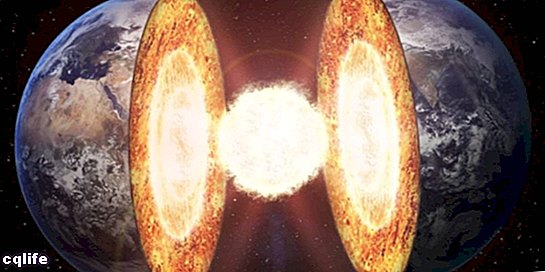- What is the Earth's core?
- Characteristics of the Earth's core
- Formation of the Earth's core
- Earth's core temperature
- Subdivisions of the Earth's core
We explain what the Earth's core is, its parts, temperature and other characteristics. Also, how it formed together with the Earth.

What is the Earth's core?
In geology, is known as the Earth's core or the core of the Earth to the deepest inner portion of the structure of our planet, that is, to its very central sphere. It is located below the terrestrial mantle, about 2,900 kilometers below the planetary surface.
Being the deepest layer of the planet, It is a very hot and dense place, which has very particular characteristics with respect to the most superficial layers, and also with respect to the other known planets, since the Earth is the densest body of all those that exist in the Solar system (with a density 5515 kg / m3 average).
For example, given its majority composition of iron and nickel (for which it was formerly known as NiFe, due to its chemical symbols), as well as other ferromagnetic minerals, the rotation of this inner sphere is responsible for generating the electromagnetic field that surrounds the planet (known as the magnetosphere), which we protects from continuously emitted solar radiation.
Obviously, no one has ever been to the Earth's core. The deepest excavations of the humanity they have barely managed to descend 12.3 km below the surface, so that the scientific explorations of the nucleus consist of theoretical and deductive analyzes, or studies by approximation through the reading of waves natural or artificial seismic.
Characteristics of the Earth's core
The earth's core is characterized by the following:
- It is the planetary center itself, a very dense and very hot place. Its average density is estimated at 11,000 kg / m3 and its temperature average exceeds 6700 degrees Celsius.
- The core is mainly composed of iron, with 5-10% nickel and other minor elements such as sulfur and oxygen. These materials exist in liquid form on the outside of the core and solid in its internal portion.
- The Earth's core is a sphere with a radius of about 3500 km, which represents 32% of the mass total of the Earth, and is larger in itself than all the planet Mars.
- It is divided into two parts: an outer (liquid) core and an inner (solid) core.
Formation of the Earth's core
The components of the Earth's core were present when the planet was born, approximately 4.6 billion years ago. Like the rest of the material in the Solar System, the Earth went through stages of intense initial temperatures, which allowed the formation of alloys particularly dense metal at its center. These materials still remain in their metallic core, subjected to the immense effect of the gravity and the Pressure.
However, the nucleus as such emerged much later, thanks to the differentiation of terrestrial materials as the planet cooled. Thus, the lighter materials such as most silicates, formed the outer layers of the mantle and the Cortex, while iron and various heavy and radioactive materials remained at the bottom. This process is known as "planetary differentiation."
Earth's core temperature
As we have said, the temperature of the Earth's core is very high, reaching 6700 degrees Celsius: hotter than the outermost surface of the Earth. Sun.
Subdivisions of the Earth's core

The core of the Earth is divided into two clearly differentiated portions:
- The outer core, that is, its most superficial layer, consists of around 2,200 kilometers of molten iron, nickel and other metals, at temperatures ranging between 4500 and 5500 degrees Celsius. It is a layer of very low viscosity, subjected to very violent convection processes, the displacement of which precisely generates the Earth's magnetosphere, acting as a gigantic dynamo.
- The inner core, that is, its deepest layer, has a radius of approximately 1,255 kilometers, made up of 70% iron and 30% nickel in a solid alloy. There is also a minimal percentage of other heavy minerals such as lead, iridium and titanium, all compacted in the same extremely dense and heavy matter, at such high temperatures that it is not capable of generating electromagnetism.
